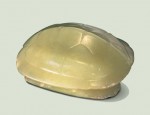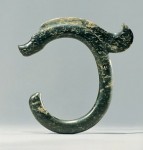Posts Tagged ‘Hongshan culture’
Jade carvings unearthed from the tomb of a Shang dynasty royal concubine
Jade carvings of the Shang-Zhou period feature a much better workmanship  than Liangzhu jade artifacts. Those excavated from the tomb of a Shang Dynasty royal concubine testify to the truth of this assertion.
than Liangzhu jade artifacts. Those excavated from the tomb of a Shang Dynasty royal concubine testify to the truth of this assertion.
The women, Fu Hao, was a concubine of King Wuding of Shang Dynasty, and her tomb in Anyang, Henan Province, was discovered in 1976 by accident. The tomb is in fact a part of the “Yin Ruins” – ruins of the capital city for the Shang Dynasty in its late period some 3,000 years ago.
Of the 1,600 relics unearthed from the tomb, 755 are jade artifacts, including two dozen exquisitely designed animal and bird figures. Let’s see just a few: two hares about to jump, their short tails upward and their long ears against the backs; a tiger with its mouth wide open; an elephant cub with its trunk swaying; and those monkeys that look so cute. The tomb is in fact a zoo of jade animals – real things like elephants, bears, monkeys, rabbits, horses, cattle, sheep, cranes, vultures, parrots, frogs and fish, as well as legendary dragons and phoenixes. There are seven small dragons coiled like alphabet C, inspiring scholars to link them to a large jade dragon of the prehistory Hongshan culture in their study of the continuity and consistency of the Chinese culture.
Two dozen parrots, in fact relieves carved on flat jade pieces, were excavated from the tomb. Two of them share a long tail, their heads arranged in symmetrical order and one side of the tail sharpened like a sword – a perfect combination of artistic value and practical use.
Jade artifacts of the Hongshan culture
 The Hongshan culture existed about 5,000 years ago, in areas drained by the Liaohe and Xilamulun rivers in northeast China. Jade artifacts of the Hongshan culture are recognized as unique in workmanship and regional character. Most of them take the shape of animals, including turtles, fish hawks, cicadas and dragons, and are just three or four centimeters long with holes drilled through–obviously personal ornaments hanging from the belts of their owners.
The Hongshan culture existed about 5,000 years ago, in areas drained by the Liaohe and Xilamulun rivers in northeast China. Jade artifacts of the Hongshan culture are recognized as unique in workmanship and regional character. Most of them take the shape of animals, including turtles, fish hawks, cicadas and dragons, and are just three or four centimeters long with holes drilled through–obviously personal ornaments hanging from the belts of their owners.
A jade dragon, 26 centimeters long, lays coiled like alphabet C. It is too large  and heavy to be used as a personal ornament. Jade dragons similar in shape but much smaller have been identified as belonging to the Hongshan culture, inferring that the larger jade dragon could be the symbol of something supernatural that held people in awe. To be more specific, the artifact could be hung for worshipping on some special occasions, say at sacrificial ceremonies. If the inference is correct, we may say that jade artifacts were no longer used purely as ornaments in times of the Hongshan culture. Time had begun for use of jade artifacts as ceremonial objects as well.
and heavy to be used as a personal ornament. Jade dragons similar in shape but much smaller have been identified as belonging to the Hongshan culture, inferring that the larger jade dragon could be the symbol of something supernatural that held people in awe. To be more specific, the artifact could be hung for worshipping on some special occasions, say at sacrificial ceremonies. If the inference is correct, we may say that jade artifacts were no longer used purely as ornaments in times of the Hongshan culture. Time had begun for use of jade artifacts as ceremonial objects as well.